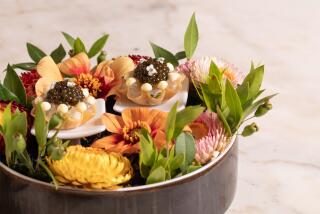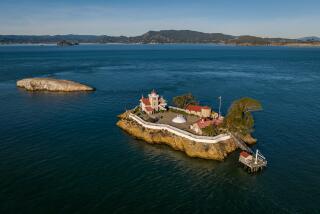A Piece of Quiet in Old Quebec
- Share via
ILE D'ORLEANS, Canada — Most visitors to the walled city of Quebec go for the rich history, the breathtaking scenery and the romance of Paris right here in North America. But what about the country mice among us? Last fall, my husband and I, our two young children in tow, took a mini-vacation on Ile d’Orleans, a tranquil island in the St. Lawrence River. We could admire the skyline of the city only 15 miles away, yet feel as if we were in rural France. We spent four days ambling through centuries-old villages and farms where English is spoken roughly, if at all, and we fell asleep to the sound of foghorns and the river rippling against the shore outside our inn.
We arrived at night, following the double arc of lights across the one bridge from Quebec City’s east side to the island. The lights seemed to end abruptly in darkness, which heightened the feeling that we had crossed a span of many years into the past. The island is sparsely lighted, and the residents want to keep it that way. The old-timers, we were told, still resent the bridge, built in 1935, as a corrupting intrusion. The island’s quiet old ways go back to its settlement in the early 1600s, a century after Jacques Cartier explored the St. Lawrence for the king of France.
Today the island is a historic district protected from industrial commercialization. Colorful hand-painted signs bid visitors “Bienvenue” (welcome) and “Au revoir” (see you again) outside the island’s six small villages, home to 7,000 people year-round and 3,000 summer residents.
Many visitors spend a day driving Le Chemin Royal, the 40-mile “royal road” that circles the island’s coast. The tourist information bureau just over the bridge rents audiotapes in English and French, carefully timed to narrate this drive. The 90-minute tape chronicles the island’s lively history and points out interesting sites, ranging from historic churches to the Chocolaterie de l’Ile in Ste. Petronille to the Maritime Park in St. Laurent, a tribute to the rowboat-building trade that thrived there in the 1800s.
Not to be missed is the museum housed in the Manoir Mauvide-Genest, built in 1734 for Jean Mauvide, France’s royal surgeon, and his wife, a native of the island. In 1759, the British occupied Ile d’Orleans while laying siege to Quebec City in the decisive battle with France for control of North America. The marks from the French cannonballs are still visible on the manor’s thick stone walls.
*
From the beginning, this has been a farming community, and, in between sightseeing stops, we snacked on fruit from roadside farm stands. But our favorite food experience was dinner at l’Atre (the Hearth), a 17th century farmhouse lighted only by kerosene lamps and fireplaces.
After parking in a small gravel lot off Le Chemin Royal, we waited for the restaurant’s 1954 Plymouth, whose driver took us down a steep driveway to the stone house.
The host, dressed in black tails, welcomed us at the front door along with strains of classical music and the inviting aromas of wood smoke and meat pies. He escorted us across the dark, sloping floors, beneath a low wood-beamed ceiling to our table, which was situated between a warm wood stove and an antique butter churn. He showed our daughter, Kate, 2 1/2, how the old iron water pump nearby worked, and then brought her an ancient but stable wood high chair. We ordered a local wine; vineyards had been one of the first plantings in this early settlement of New France.
While waiting for our meal of 17th century favorites--pate, beef consomme and meat pie--we took in our museum-like surroundings. Along the white stucco walls were hinged windows with 12 wood-latticed panes. Copper teapots, antique flatirons and ceramic pots holding dried flowers adorned the sills, and candles and hurricane lamps decorated the walls.
Behind our table was a set of narrow, steep stairs leading to an attic. We were surprised and delighted when the host beckoned us up the steps between courses, a ritual during l’Atre meals. He poured us each a small glass of maple liqueur and left us to explore the ancient attic, with its spinning wheels, vintage checkerboard, newspaper clips and guest books from more than 65 years ago. Since Ile d’Orleans was the first stop for many families moving to Canada from Europe, some of the yellowing papers recounted immigration history. Today, many visitors to the island come specifically to trace their genealogy.
We returned downstairs for dessert of iced maple mousse and maple-sugar tart with creme fraiche. It was clear what the restaurant’s chauffeur had meant when he stated simply, “It’s a very special place.”
For a different kind of dining experience, we had lunch at one of the island’s seven cabanes a sucre, or sugar shacks. The province of Quebec is North America’s largest producer of maple sugar, and most of the sugar shacks not only sell their products but also serve maple-based meals. We chose Sucrerie Blouin because it was on the riverfront, and we expected a quiet pancake lunch. Instead, we opened the door of the secluded red ranch building and found ourselves in another world.
Sucrerie Blouin was crowded with local families enjoying live music and folk dancing while snacking on beans, sausage, potatoes and bread. The friendly owners spoke little English but urged us to join the dancing and sample their maple fare. They even figured out Kate’s dismay when they served us beans instead of pancakes, so they brought pancakes and syrup for dessert.
After lunch we stopped at L’Etang le Nordet, one of four freshwater fishponds on the island. Because they’re on private property, no license is needed, and gear is loaned for free. While my husband, Tony, fished for trout, the children and I enjoyed the idyllic setting--masses of wildflowers, cows grazing in adjacent fields, the passing ships on the river, the distant mountains marking the U.S. border in Maine. Our infant son, Andy, delighted in seeing the fish leap out of the water when the pond’s jolly owner tossed bait on the surface.
Even so, the fish eluded Tony’s hook, which he was quick to blame on the chilly weather. Those with better luck can take away their catch for about 30 cents per inch. Some local restaurants will prepare it for you, among them Manoir Mauvide-Genest and Le Moulin de St. Laurent, a charming stone flour mill from 1720.
We next stopped to take in the gorgeous views from a wooden observation tower on the far eastern end of the island, where the St. Lawrence widens and begins to join salt water.
Most appreciated of all our island experiences was the generous hospitality we received when we realized we had locked our keys in the car. We will never forget Frederic and Josie Smith, a young Quebecois couple visiting Ile d’Orleans for the day to pick apples, tour old houses and climb the tower. They kindly drove us to the village to find a phone and returned to wait with us until a locksmith had remedied our situation. Kate thanked them the best she could, with a special rendition of “Frere Jacques.”
How wonderful it was to arrive back at our inn, Auberge la Goeliche, and collapse on the brass bed in our room overlooking the river and the Quebec City skyline. The inn’s restaurant had closed, but the fellow at the front desk cheerfully offered to bring food to our room, including salad with yellow crown cherries and bagels with smoked salmon, cream cheese and capers. And for Kate, a slice of cheese lasagna. Another night we would enjoy the inn’s specialty, le gateau Goeliche, a cake laced with pears and chocolate.
This accommodating spirit, welcoming even small children to a top-rated historic inn, marked almost every encounter we had on Ile d’Orleans. After four days there, we crossed the bridge back to the mainland with reluctance. When I opened my suitcase at home to unpack, the smell of wood smoke filled the room.
(BEGIN TEXT OF INFOBOX / INFOGRAPHIC)
GUIDEBOOK
City Island Charm
Getting there: Air Canada, American, Northwest and Canadian International have connecting service (one plane change) from LAX to Quebec City. Restricted round-trip fares start at $521.
Where to stay: Auberge la Goeliche, 22 Chemin du Quai, Ste. Petronille, Quebec GOA 4CO. Telephone (418) 828-2248. Double, including full breakfast, $107.
Locals also recommend: Auberge Chaumonot, 425 Chemin Royal, St. Francois, Ile d’Orleans, Quebec GOA 3SO. Tel. (418) 829-2735. This is on the more remote eastern end of the island. Double, full breakfast, $86 to $93.
Motel de l’Ile d’Orleans, 507 Route Prevost, St. Laurent, Quebec GOA 3ZO. Tel. (418) 828-2048. A hilltop setting with panoramic view, closed in winter. Room for two, $32 to $43.
Where to eat: L’Atre, Ste. Famille. Tel. (418) 829-2474. Quebecois cuisine in a 1680 farmhouse.
Le Moulin de St. Laurent, St. Laurent. Tel. (418) 829-3888. Quebecois cuisine in a 1720 flour mill.
Manoir Mauvide-Genest, St. Jean. Tel. (418) 829-2630. French cuisine in the 1734 home of the king’s surgeon.
Sucrerie Blouin, St. Jean. Tel. (418) 829-2587. Maple-sugar specialties.
For more information: Ile d’Orleans Tourist Information Bureau, 490 Cote du Pont, St. Pierre, Quebec GOA 4EO. Tel. (418) 828-9411, fax (418) 828-2335.
Canadian Tourism Commission, 550 S. Hope St., 9th Floor, Los Angeles, CA 90071. Tel. (213) 346-2700, fax (213) 346-2767.
More to Read
Sign up for The Wild
We’ll help you find the best places to hike, bike and run, as well as the perfect silent spots for meditation and yoga.
You may occasionally receive promotional content from the Los Angeles Times.






